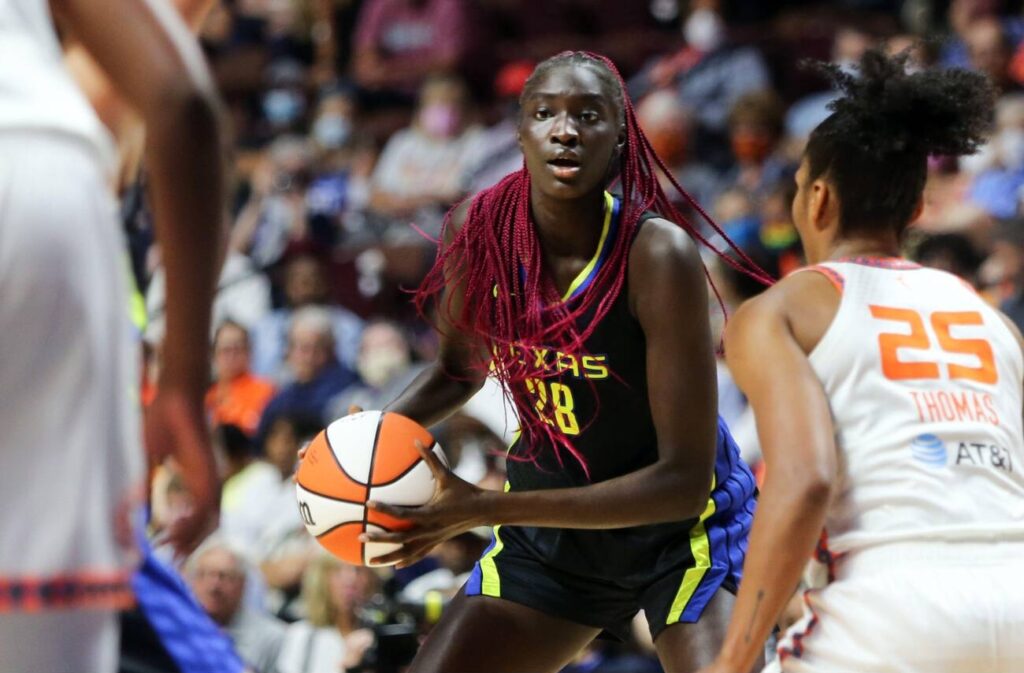Is the WNBA a profitable league this year? Well, we are about to find out. Stay with us, as we unravel the hidden treasures of the WNBA.
Since its inception in 1996, the Women’s National Basketball Association (WNBA) has emerged as a formidable force in professional women’s sports.
However, people still have questions like “Is the WNBA a profitable league”, We’ve answered that here.
With talented athletes, passionate fans, and a growing global presence, the league has made significant strides in promoting gender equality and elevating women’s basketball to new heights.

Is the WNBA profitable this year? Does the league generate enough revenue to sustain its operations and provide its players with substantial compensation?
In this blog post, we delve into the financial landscape of the WNBA, exploring its revenue streams, costs, and efforts to ensure long-term sustainability.
Table of Contents
Key Takeaways
- The WNBA has made significant strides in increasing its revenue streams recently. This includes lucrative broadcasting deals, sponsorships, merchandise, and ticket sales. The league’s partnerships with major companies have boosted its profitability.
- The WNBA has seen a rise in fan engagement, contributing to its profitability. The league has focused on creating a more immersive and interactive fan experience, including social media campaigns, behind-the-scenes content, and community outreach initiatives.
- The WNBA has tried to improve player compensation, contributing to the league’s overall profitability. By providing competitive salaries and benefits, the league has been able to attract and retain top talent, enhance the on-court product, and draw more fans and sponsors.
What is the WNBA?

The WNBA (Women’s National Basketball Association) is a professional basketball league in the United States that features female players.
It was established in 1996 and is considered the world’s premier professional women’s basketball league.
The league comprises 12 teams and operates under the National Basketball Association’s (NBA) umbrella.
The WNBA was created to provide opportunities for female basketball players to compete at the professional level and promote women’s basketball.
Many of the players in the WNBA are among the best in the sport and have achieved significant recognition for their skills and contributions to the game.
The league’s regular season typically runs from May to September, with each team playing 34 games.
The top eight teams advance to the playoffs, culminating in the WNBA Finals to determine the league champion.
The WNBA has played a vital role in advancing women’s sports and promoting gender equality in athletics.
It has provided a platform for female athletes to showcase their talent and has inspired young girls worldwide to pursue basketball and other sports.
The WNBA has recently seen increased popularity and attention, with growing support from fans, media coverage, and corporate sponsorships.
The league has also been at the forefront of social activism, with players advocating for social justice issues and using their platform to raise awareness about important causes.
Overall, the WNBA is a significant representation of women’s basketball and continues to promote equality and empower female athletes.
This significant impact of the league always leaves people asking the question, “Is the WNBA a profitable league?”
Related: Is Airbnb Profitable In 2023? Where to Invest?
Understanding the Financial Landscape of the WNBA
The financial landscape of the Women’s National Basketball Association (WNBA) is influenced by various factors, including revenue streams, player salaries, team valuations, and overall league profitability.
While the WNBA has experienced significant growth and increased investment in recent years, it still faces challenges compared to its male counterpart, the NBA.
Here are some important factors to consider when talking about profitable WNBA teams:
#1. Revenue Streams
The WNBA generates revenue through multiple channels, including ticket sales, sponsorships, merchandise sales, and media rights. However, these revenue streams are generally smaller in scale than those of the NBA.
The league has been actively working on expanding its fan base and securing more lucrative sponsorship deals to increase revenue and help raise more profitable WNBA teams.
#2. Player Salaries
WNBA player salaries have historically been lower compared to the NBA. The average player salary in the WNBA is significantly lower than that of the NBA, primarily due to differences in revenue and overall market demand.
However, there have been efforts to improve player compensation, including a new collective bargaining agreement in 2020 that increased player salaries and introduced additional benefits. This will increase the chances of raising more profitable WNBA teams.
#3. Team Valuations
WNBA team valuations have been on the rise, reflecting increased interest and investment in the league.
However, they are generally lower compared to NBA franchises. There are less profitable WNBA teams compared to the NBA.
Factors like market size, team success, and overall league popularity contribute to team valuations. Successful franchises with strong fan bases tend to have higher valuations.
#4. Financial Support
The NBA provides financial support to the WNBA, helping to cover certain operating costs and bridge the revenue gap. This support helps ensure the stability and growth of the WNBA.
Additionally, some NBA teams have affiliations or partnerships with WNBA teams, leading to shared resources and potential.
Also, read – How To Sell Stock On Cash App: 15 Easy Ways To Do It in 2023
#5. Sponsorships and Partnerships
The WNBA has been actively seeking and securing partnerships with sponsors and companies to enhance its financial position.
Sponsorships provide financial support and also help promote the league which will empower more profitable WNBA teams.
Increasing visibility and attracting high-profile sponsors are crucial for the league’s financial growth.
#6. Television and Media Rights
Broadcast rights play a significant role in the financial landscape of any sports league. The WNBA has secured television deals with various networks to ensure broader coverage and exposure.
Media rights deals contribute to revenue generation and help increase the league’s overall popularity.
#7. Fan Support and Attendance
Fan support and attendance at games are vital for the financial health of the WNBA. Strong fan engagement translates into increased ticket sales, merchandise purchases, and potential growth in other revenue streams.
Building a passionate and dedicated fan base remains an ongoing objective for the league.
While the WNBA has improved its financial landscape, challenges remain in achieving revenue parity with the NBA.
However, increased investment, growing fan interest, and support from the NBA provide a solid foundation for the WNBA’s continued growth, and financial stability in the future will help in producing profitable WNBA teams.
Is the WNBA A Profitable League?

The profitability of the Women’s National Basketball Association (WNBA) has been a topic of discussion and analysis since its establishment in 1996.
While the league has faced various challenges and has not consistently generated profits in its earlier years, the situation has evolved.
The WNBA is not yet a profitable league. This year, the WNBA reported its first quarterly profit, but this was largely due to a one-time gain from the sale of a team. If you exclude the one-time gain, the WNBA will still lose money this year.
There are several reasons why the WNBA is not profitable. One reason is that the league’s revenue is relatively low. The WNBA’s revenue of $1.5 billion is a fraction of the NBA’s revenue of $10 billion.
Another reason is that the WNBA’s expenses are relatively high. The league’s operating expenses of $1.6 billion include player salaries, marketing costs, and other expenses.
The WNBA also faces several challenges, including low revenue, high expenses, competition from other women’s sports leagues, and a lack of exposure.
Despite these challenges, there are some positive signs for the WNBA. The league’s revenue has been growing in recent years, and it has attracted new sponsors and media partners.
The WNBA is also becoming more popular with fans, and attendance at games has been increasing.
There are several things that the WNBA can do to become more profitable, including increasing revenue, reducing expenses, and increasing exposure.
Overall, the WNBA is not yet a profitable league, but it is making progress. The league has several challenges to overcome, but the WNBA can become profitable in the future.
Read this article – Are Laundromats Profitable: Is Buying A Laundromat A Good Investment?
Why is the WNBA not Profitable?
There are several reasons why the WNBA is not profitable. One reason is that the league’s revenue is relatively low. The WNBA’s revenue of $1.5 billion is a fraction of the NBA’s revenue of $10 billion.
Another reason is that the WNBA’s expenses are relatively high. The league’s operating expenses of $1.6 billion include player salaries, marketing costs, and other expenses.
What are the Challenges Facing the WNBA?
The WNBA faces several challenges, including:
- Low revenue: The WNBA’s revenue is relatively low compared to other professional sports leagues. This is due to several factors, including lower media rights deals and lower ticket sales.
- High expenses: The WNBA’s expenses are relatively high compared to other professional sports leagues. This is due to several factors, including player salaries and marketing costs.
- Competition from other women’s sports leagues: The WNBA faces competition from other women’s sports leagues, such as the NWSL and the LPGA. These leagues are also struggling to turn a profit, but they are gaining popularity.
- Lack of exposure: The WNBA has less exposure than other professional sports leagues. This is due to several factors, including lower media coverage and fewer sponsorships.
What is the Future of the WNBA?
The future of the WNBA is uncertain. The league has struggled to turn a profit for most of its existence, and it faces several challenges.
However, there are some positive signs for the WNBA. The league’s revenue has been growing in recent years, and it has attracted new sponsors and media partners.
The WNBA is also becoming more popular with fans, and attendance at games has been increasing.
How can the WNBA become more Profitable?
There are several things that the WNBA can do to become more profitable, including:
- Increase revenue: The WNBA can increase revenue by attracting more media rights deals and sponsorships. The league can also increase revenue by selling more tickets and merchandise.
- Reduce expenses: The WNBA can reduce expenses by negotiating lower player salaries and other costs.
- Increase exposure: The WNBA can increase exposure by getting more media coverage and sponsorships. The league can also increase exposure by playing more games in front of larger crowds.
The WNBA is a valuable asset to the sport of basketball. The league provides a platform for women to compete at the highest level, and it inspires young girls around the world.
The WNBA faces several challenges, but the league can become profitable. The WNBA needs to focus on increasing revenue, reducing expenses, and increasing exposure.
Profitable WNBA Teams
There are no profitable WNBA teams. The entire WNBA league is not profitable. This year, the WNBA reported its first quarterly profit, but this was largely due to a one-time gain from the sale of a team. If you exclude the one-time gain, the WNBA still lose money this year.
There are several reasons why WNBA teams are not profitable. One reason is that the league’s revenue is relatively low. The WNBA’s revenue of $1.5 billion is a fraction of the NBA’s revenue of $10 billion.
Another reason is that WNBA teams have high expenses. The teams’ operating expenses include player salaries, marketing costs, and other expenses.
The WNBA also faces several challenges, including low revenue, high expenses, competition from other women’s sports leagues, and a lack of exposure.
Despite these challenges, there are some positive signs for the WNBA. The league’s revenue has been growing in recent years, and it has attracted new sponsors and media partners. The WNBA is also becoming more popular with fans, and attendance at games has been increasing.
There are several things that the WNBA can do to become more profitable, including increasing revenue, reducing expenses, and increasing exposure.
Overall, WNBA teams are not profitable, but the league is making progress. The league has several challenges to overcome, but WNBA teams can become profitable in the future.
What is the Financial Status of the WNBA?
The financial status of the WNBA has been a topic of much discussion and scrutiny in recent years.
While there is no denying that the league has struggled to achieve the same level of profitability and commercial success as the NBA, This problem has been exacerbated by various causes.
One of the primary issues facing the WNBA is the relative lack of media exposure and coverage that it receives compared to other major sports leagues.
Even though the quality of play is often on par with the men’s game, the WNBA has historically struggled to attract large audiences and generate significant revenues from television rights and sponsorships.
Another challenge the WNBA has faced is the comparatively low salaries that players receive, particularly compared to the astronomical sums that some NBA players earn.
This has made it difficult for the league to attract and retain top talent, leading to complaints and criticism from players and fans alike.
However, despite these challenges, there are signs that the WNBA may be poised for a resurgence in the coming years.
Recent efforts to increase media exposure and investment in the league have already started to bear fruit, with higher ratings and increased interest from sponsors and advertisers.
Additionally, several innovative new initiatives, such as the recent partnership between the WNBA and NBA 2K to create a video game version of the league, have helped to expand the fan base and generate new revenue streams.
What is the value of WNBA Franchises?
The value of WNBA franchises is difficult to calculate. It’s not like the NBA, where the market and revenue are more extensive, but they have been experiencing growth in their worth over the years. In the early years, WNBA teams were valued at around $10 million.
They have increased in value, and some franchises are worth over $100 million. It’s a massive improvement from the past.
The increase in value is due to several factors. One of which is the growth of viewership and fans.
Women’s basketball has gained a more prominent platform and attention. People now understand that women can play just as well as men, sometimes even better.
This understanding has led to an increase in interest, followership, and revenue.
Another significant factor that has increased the value of WNBA franchises is player advocacy and activism.
Women players have been standing up for their beliefs and creating change in the league and society.
They use their platforms to promote important issues and advocate for themselves and their peers. Their voice and actions have created more interest and investment in the league.
WNBA franchises are a valuable asset to investors because of their potential. They have untapped market opportunities and an audience that is hungry for growth.
They have talented and passionate athletes who will continue to innovate and push the game forward.
Don’t forget to read through – How To Make Money From Elevenlabs in 2023 | Full Guide
How does the WNBA League distribute its Revenue?
The WNBA is one of the world’s premier women’s professional basketball leagues, boasting some of the most talented and exciting players on the planet.
And as with any successful sports league, revenue is a crucial part of its operations. So how exactly does the WNBA distribute its revenue?
To begin with, the WNBA generates revenue through several sources, including sponsorships, broadcast deals, ticket sales, and merchandise sales.
However, unlike many men’s professional sports leagues, the WNBA doesn’t generate the same level of revenue, which in turn means that it has a smaller pot to divide amongst its players and teams.
So how does the WNBA go about dividing its revenue? The league has what is known as a collective bargaining agreement (CBA), which outlines the rules and guidelines around how revenue is distributed.
The most recent CBA, signed in January 2020 and set to last for eight years, sets out several key provisions around revenue distribution.
One of the most important elements of the CBA is the player compensation structure. Under this structure, players receive a share of revenue that ranges between 20% and 30%, depending on the league’s financial performance.
This revenue share is then split amongst the league’s players, with each player’s compensation depending on a range of factors, such as experience, skill level, and role on the team.
Another key element of the CBA is the team salary cap, which is set at $1.3 million for the 2021 season. Each team can only spend up to $1.3 million on player salaries for the entire season.
While this may seem like a lot of money, it pales compared to the salary caps of many men’s professional sports leagues, which can be upwards of $200 million.
Finally, the CBA also sets out guidelines for revenue sharing between teams. Under this system, teams receive a share of league-wide revenue that is divided according to several factors, such as team performance and market size.
How does the WNBA Stay Afloat?
The Women’s National Basketball Association (WNBA) has managed to stay afloat and thrive over the years through a combination of factors contributing to its success and financial stability.
Here are some key aspects that have helped the WNBA maintain its presence and viability:
#1. NBA Support and Partnership
The WNBA benefits from its close association with the National Basketball Association (NBA).
The NBA provides financial support and resources to the WNBA, including marketing assistance, shared services, and operational infrastructure.
This collaboration has helped the WNBA regarding exposure, funding, and stability.
#2. TV and Media Deals
Securing lucrative television and media deals has been vital for the WNBA’s financial stability. Over the years, the league has established partnerships with major broadcasters, such as ESPN and CBS Sports, ensuring significant coverage and exposure.
These broadcasting contracts generate revenue for the league, increasing its financial viability.
#3. Sponsorships and Partnerships
The WNBA has attracted a range of corporate sponsors and partners, including prominent companies like Nike, AT&T, and Deloitte.
Sponsorship deals provide crucial financial support to the league and its teams, contributing to their operational expenses, player salaries, and overall growth.
Additionally, partnerships with organizations like Boost Mobile and Jamba Juice have further bolstered the league’s financial stability.
You might find this interesting: 30 Partnership Business Examples in 2023 | Networth
#4. Dedicated Fanbase
The WNBA has cultivated a passionate and loyal fanbase over the years. Fans appreciate the high level of play, the talent of the athletes, and the league’s commitment to women’s sports.
The fans’ support through ticket sales, merchandise purchases, and game attendance contributes significantly to the league’s revenue stream to also build profitable WNBA teams.
#5. Player Development and Global Expansion
The WNBA has prioritized player development and attracting international talent. This focus has helped enhance competition and attract a broader audience.
Expanding the league’s reach globally through partnerships with international basketball organizations, such as FIBA, has opened up new markets and revenue opportunities.
#6. Cost Management
The WNBA has implemented cost management strategies to ensure financial stability. While player salaries are not as high as those in the NBA, the league has managed to maintain a balance between competitive compensation and sustainable financial practices.
This approach helps to control expenses while still attracting and retaining top talent with the hope of raising profitable WNBA teams.
#7. Commitment to Social Justice
The WNBA has embraced social justice initiatives and is committed to important causes. The league and its players have advocated for racial equality, gender equity, LGBTQ+ rights, and other social issues.
This dedication to social justice has resonated with fans and sponsors, attracting support and enhancing the league’s overall image.
By leveraging its NBA partnership, securing media deals, attracting sponsorships, nurturing a dedicated fanbase, focusing on player development, managing costs, and championing social justice, the WNBA has stayed afloat and continues to grow.
The league’s ability to generate revenue and maintain financial stability has been crucial in supporting the growth of women’s basketball and paving the way for a sustainable future.
How Much Do WNBA Players Make This Year?
The WNBA has always been an inspiring and thrilling sport to watch, especially for women who aspire to become professional basketball players.
However, one question that keeps popping up among WNBA fans is, “How much do WNBA players make this year?”
As we head towards 2024, we can expect a significant increase in WNBA player salaries. The WNBA has consistently tried to uplift its players’ compensation in recent years.
Last year, the WNBA and the Women’s National Basketball Players Association agreed to a groundbreaking collective bargaining agreement, significantly increasing players’ salaries.
In 2020, the average salary of a WNBA player was $130,000, a considerable improvement from the previous years. By 2024, the league aims to double that number, making the average salary around $260,000.
With more and more businesses and organizations stepping up to sponsor women’s basketball teams and athletes, this goal seems more achievable than ever before.
However, it’s worth noting that WNBA player salaries are not solely based on sponsorships and league profits. Rather, players are compensated for their talent, skills, and experience, much like in any other sport.
So, a WNBA rookie might not make as much money as a seasoned player who has played in the league for years and has made a name for herself.
This helps in answering the question, “Is the WNBA a profitable league?”
People also read How Much Is A Vending Machine Permit Across The States In the USA
NBA vs. WNBA
Two of the biggest professional basketball leagues in the world are the NBA (National Basketball Association) and the WNBA (Women’s National Basketball Association).
While they involve talented players competing at the highest level, they differ in revenue, salaries, viewership, attendance, and ratings.
We’ll look at these distinctions in more detail below. There are less profitable WNBA teams.
#1. Revenue
Regarding revenue, there is a considerable difference between the NBA and the WNBA. The NBA generates over $8 billion in revenue, while the WNBA has an estimated $60 million.
This difference in revenue can be attributed to several factors, such as endorsements, merchandising, and broadcasting rights.
#2. Salaries
As expected, the two leagues have a significant gap in player salaries. In the NBA, the average player’s salary is around $7.7 million per year, while in the WNBA, the average player’s salary is $116,000 per year.
This is a considerable difference, but it’s worth noting that the top players in the WNBA can make around $500,000 annually.
#3. Viewership
Another significant difference between the NBA and WNBA is the number of viewers. While the NBA draws a significant global audience, the WNBA struggles to attract large crowds.
This contributes to why we don’t have many profitable WNBA teams. The NBA has a viewership of approximately 40 million people worldwide, while the WNBA averages around 240,000 viewers per game.
#4. Attendance
Attendance is another significant difference between the two leagues. The NBA has an average attendance of around 17,800 people per game, while the WNBA averages around 7,700.
It’s also worth noting that some WNBA teams have played in smaller venues, which may have affected their attendance numbers.
#5. Ratings
The ratings for NBA games are considerably higher than those for WNBA games. NBA games draw an average rating of around 1.9, while WNBA games average around 0.2.
Conclusion on ‘Is the WNBA A Profitable League’
In conclusion, the WNBA has made significant strides toward becoming a profitable league this year.
While it has faced challenges and obstacles, the league has demonstrated its ability to attract fans, secure sponsorship deals, and generate revenue.
The increased media coverage and investment from major corporations have contributed to its growing popularity and financial success.
Looking ahead, the WNBA must continue building on this momentum. The league can solidify its position as a profitable sports entity by continuing to invest in marketing and promotion, fostering player development, and expanding its fan base.
With ongoing support from fans, sponsors, and media outlets, the WNBA is well on its way to becoming a thriving and financially viable league in the years to come and building profitable WNBA teams.
Frequently Asked Questions on ‘Is the WNBA A Profitable League’
Is the WNBA profitable in 2024?
Yes, the league has experienced steady growth and increased revenue over the past few years. With major sponsorship deals and a dedicated fan base, the WNBA is on track to continue its profitability.
What changes has the WNBA made to increase profitability?
The league has focused on expanding its fan base and creating more engaging content for viewers. They have also partnered with major corporations to increase revenue streams, such as the Nike jersey deal signed in 2022.
How do player salaries factor into the WNBA’s profitability?
While player salaries have increased recently, the league’s overall profitability has not been heavily impacted. The WNBA is focused on balancing competitive pay for players with responsible financial management.
Are there plans for further expansion in the WNBA?
Yes, the league is exploring options for expanding to new markets to grow its fan base and increase revenue. However, the expansion will be done responsibly and sustainably.
What is the overall outlook for the WNBA’s financial future?
The WNBA has a strong foundation for continued profitability, steady growth, and a dedicated fan base. While challenges and obstacles may exist, the league is committed to smart financial management and long-term success.






The stories you shared about endorsement deals and the league’s influence on social issues highlight the WNBA’s powerful role beyond the scoreboard. It’s more than a league; it’s a platform for empowerment, inclusivity, and meaningful change.
Thank you for dispelling myths and showcasing the profitability of the WNBA, not just in monetary terms but in the broader sense of empowering women athletes and inspiring the next generation. Here’s to the continued success and growth of this phenomenal league! 🌟🏀
Thank you for your review. We appreciate the effort you made in pointing out those facts.